Looking west at the intersection of Trent Dr. and Erwin Rd., 1950.
(Courtesy The Herald-Sun Newspaper)
The erstwhile dormitories clustered around the intersection of Trent Drive and Erwin Road were built between 1942 and 1951; for a period of time, this cluster was known as 'North Campus' - an appellation it appears to have shed at this point.
The oldest of the three structures was built on the northwest corner of Trent Dr. and Erwin Rd. in 1942 as a dormitory for the nursing school. The nursing school at Duke admitted its first students to a three-year program in 1931 and began awarding baccalaureate degrees in 1938. I'm not sure if the latter innovation was the impetus for the construction of a dormitory, but local architect George Hackney was retained to design a Georgian Revival structure. It seems rather an odd location to me - then a decent distance from the medical complex at Duke, directly adjacent to the rail spur that carried coal south from the main line to the Duke power plant. Perhaps the then-residential setting of Erwin Road seemed like a good location for a dormitory.
That character began to change decidedly with the construction of the Veterans Administration Hospital ~ 2 blocks to the west of the nursing dormitory in 1950-1952. Concomitantly, Duke began the construction of two new dormitories on the south side of Erwin Road.
Looking north at the under-construction Hanes House and Men's Graduate Student Center, 1952.
(Courtesy The Herald-Sun Newspaper)
Hanes House, located on the southwest corner of Erwin and Trent, was named for Elizabeth Hanes, wife of Frederic Moir Hanes (1883-1946), a professor and Chair of Internal Medicine at Duke. It was constructed as a dormitory and teaching facility for nursing students, and completed in 1952. The original nursing dormitory on the north side of Erwin Road became known as Hanes Annex.
The Men’s Graduate Student Center, on the southeast corner of Trent Dr. and Erwin Road, was built in 1952 as well, and provided dormitory space for 300 male graduate students. It contained a dining room and other services for students.
By the mid-1970s, all three buildings were in use as undergraduate dormitories, and the area became known as 'North Campus'. The Men's Graduate Student Center was renamed Trent Hall. By the 1980s, at the latest, it was an entirely freshman campus.
I know this because, in 1988, I moved into Hanes Annex as a Duke Freshman; to show how seriously I take ED, I proffer the only two pictures I have of the original front of Hanes Annex with, uh, some guy in them.
Front of the nursing dormitory/Hanes Annex, August 1988.
Front of the former nursing dormitory / Hanes Annex, December 1988. I wish I could say that I was wearing a hat, but, hey - it was the 80s.
Jokes about Hanes Annex abounded - I don't know if it was really all that bad - it hadn't been renovated seemingly since opening in 1942. We were convinced in 1988 that Duke hoped to get rid of us by placing us there. If the "low-impact, break-away walls" didn't fall on us, crossing a very busy Erwin Road that then served as the connector between 15-501 and the Durham Freeway, which had its western terminus at Erwin Road next to Sam's Quick Shop would certainly do us in as we attempted to cross morning and evening traffic.
In 1993, Duke's academic council implored the university to do away with North Campus entirely, but to close "at least Hanes Annex, one of our least-desirable dormitories." It stood vacant after 1993, but a $4.5 million renovation removed the original front entrance, replacing it with a curved glass facade, and removed the original side entrance. A new side entrance was added on Trent Dr. The building reopened in 2000 with classrooms and gallery space. The building was renamed the John Hope Franklin Center after the historian and civil rights advocate.
Trent appears to have become the unfortunate destination of sophomore students in the mid-1990s, after freshmen were consolidated on East Campus. I'm not sure when it last housed students, but is now comprised of office space.
Hanes appears to have stopped housing students after the freshman consolidation on East Campus in the 1990s, but continued to house nursing and PA programs; the PA program has recently moved to the former Blue Cross Blue Shield Building on South Duke St.
Former Hanes Annex / now John Hope Franklin Center, 04.04.09
Hanes House, 04.04.09
Trent Hall, 04.04.09
Find this spot on a Google Map.
36.007906,-78.934219

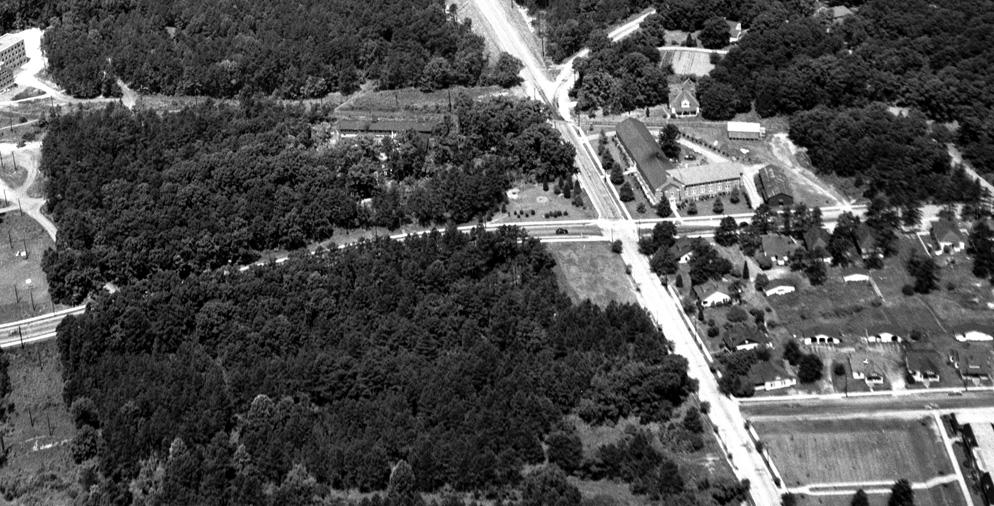
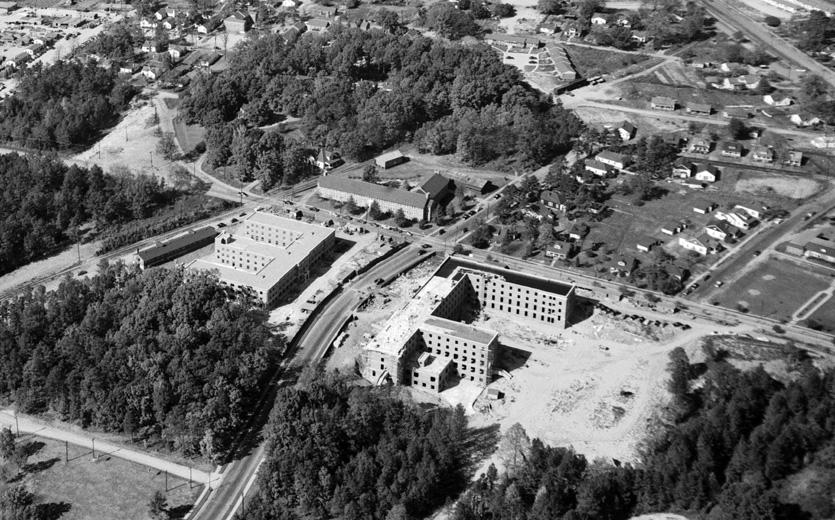
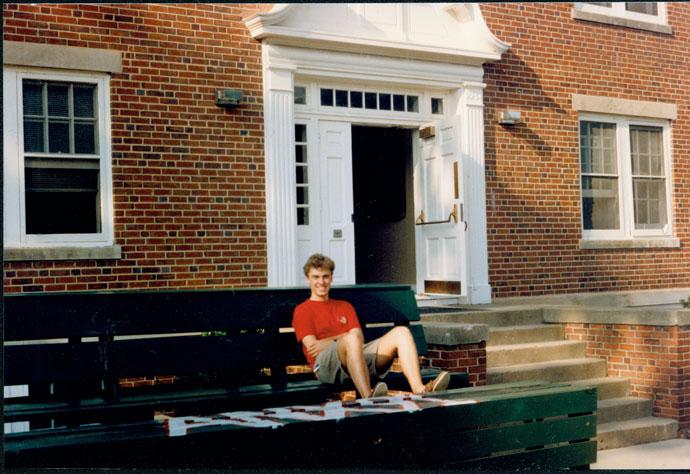
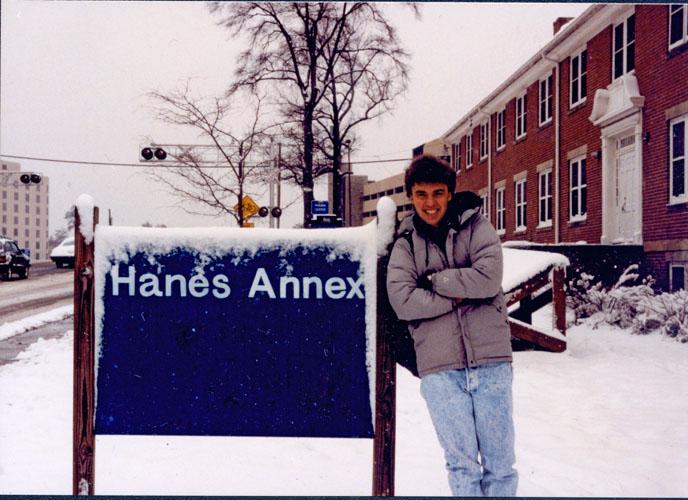

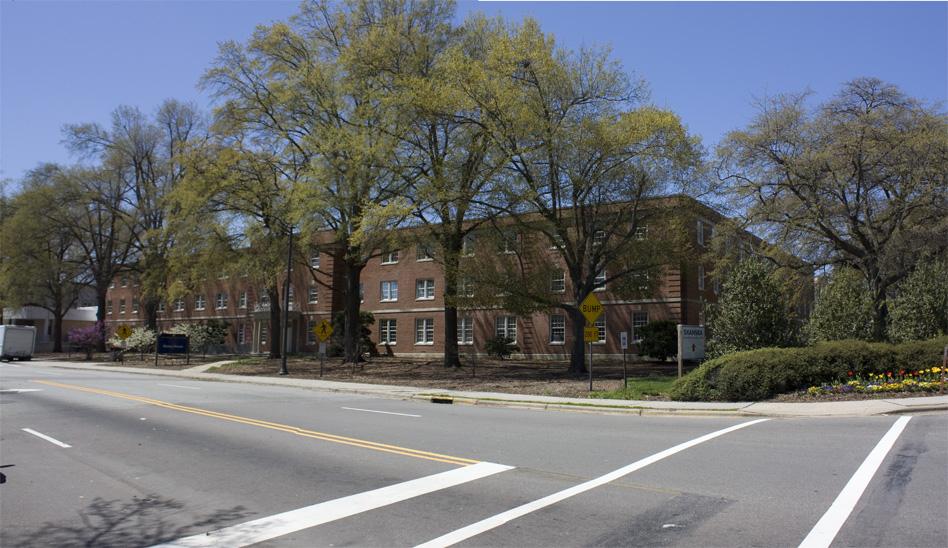

Comments
Submitted by cat (not verified) on Mon, 5/4/2009 - 3:04pm
The Independent asked if I would write a tribute to John Hope Franklin talking about the creation of the John Hope Franklin Center. Here it is:
One of the luckiest days of my life was when Duke University President Nannerl Keohane asked if I would be interested in working on converting the former nursing dorm on the corner of Trent Street and Erwin Road into a visionary center suitable to the legacy of Dr. John Hope Franklin. Interested? I was ecstatic. John Hope (as he insisted I call him) has been my role model since adolescence, when I first read From Slavery to Freedom. Long before I came to Duke, he was my exemplar of the serious humanities scholar who had made a difference in the world. His work as a historian, in Brown v. The Topeka Board of Education, had contributed to the end of segregation. His subsequent work had been directed to such causes as the anti-apartheid struggle, slave reparations and underfunded public schools. He set the standard for how the life of the mind, when relentless and true, can be a weapon of social change that, in his words, is "more healthy and constructive than the exchange of bullets."
Words are barely adequate to express my gratitude for his abiding belief in the relationship between scholarship and activism, between humanistic research and social change. I tried many times to tell him what he meant to me, and ended up, each time, utterly tongue-tied. I've talked to many others who felt similarly miniscule in his presence. When Karla Holloway, then Dean of the Humanities and Social Sciences, and Bruce Kuniholm, then a fellow Vice Provost, and I began poring over architectural plans and budgets, and meeting with faculty, students and other administrators to create a "center of centers" to honor his legacy—33,000 square feet of seminar rooms, conference spaces, meeting spaces, art galleries and offices, with state-of-the-art communications technology—we felt that we had finally found something worthy to express our debt to him.
But we were apprehensive. We knew that John Hope was conscientious about the deployment of his name. He carried his name, like his person, straight and tall in the world. He always represented. Previously, he had rejected the idea of having a center for African-American studies named after him, insisting he was a historian of America and the world—not only of African-Americans. He argued that any history that ignored the contributions of African-Americans was partial and weak, just as any scholarship that failed to acknowledge racism's violent past of slavery and segregation and its continuing material and psychological costs was inaccurate and inadequate. He was a good, responsible historian, not just an African-American historian, he insisted. He would permit his name only on a center that encompassed his wide principles.
We were nervous when we showed him the proposal for the John Hope Franklin Center for Interdisciplinary and International Studies that would include a central John Hope Franklin Humanities Institute, a space for serious, sustained reflection, scholarship and public programming. Our description called the Franklin Center "a consortium of programs dedicated to the idea that knowledge should be shared ... fueled by the commitment to address problems that have faced humanity for centuries." We paused, waiting to see if he would lend his name to such a building. He smiled, "That should cover it," he joked, both modest and amused that we were worried it wasn't enough.
He had a marvelous laugh, as expansive and generous as he was. As a practice, he said what he believed whenever it was the right time to say it. He maintained a lifelong sense of outrage over racism and injustice, over any violation of human rights worldwide. And yet he always insisted that "Hope" wasn't just his middle name but also his motivation. He refused to waste time in pettiness and resentment, and dismissed disciplinary in-fighting as "stupidity." He took the time to talk to any child, to anyone he met anywhere, on the street, in a grocery line, at a restaurant, but didn't want to waste a second on unproductive academic whining. Maybe that's what kept him hopeful.
The last time we had dinner together, a week after President Barack Obama's inauguration, he marveled that he'd lived to witness a black family move into the White House. He used the word "miracle." Perhaps. But also, for John Hope, just deserts.
Clear-eyed, focused, seriously radical hope: How did he manage that for 94 years?
One day, back when the Franklin Center was under construction, he joined us on a tour of the site. The architect handed out hard hats and led us through the welter of dust and cacophony of hammers and buzz saws. This was in 2000, so John Hope was well into his 80s, and we edged past holes yawning a full story below. We were terrified he might hurt himself, but he proved as nimble as any of us. A murmur went through the building that the elderly gentleman in the tie (did he go anywhere without a dapper tie?) was the person after whom this new center would be named, so the workers were deferential as he came through and, being John Hope, he stopped and introduced himself to each one, shaking hands with all and even complimenting one group of workers on their meticulous plastering. The look of awe in their faces was one I recognized.
When we arrived at the conference room, one of the construction bosses offered John Hope a magic marker. It had become a tradition to have visitors sign spaces in between the beams. Wallboard now covers this bit of history, of course, but someday, when the building is torn down, the signatures will be there, preserved for posterity.
He wrote his full, neat autograph. Then, grinning impishly, he scribbled: "John Hope Was Here!"
He certainly was. And, for that, our world is a far better place.
Formerly Vice Provost for Interdisciplinary Studies, Cathy N. Davidson is an English Professor and the John Hope Franklin Humanities Institute Professor of Interdisciplinary Studies at Duke University.
Submitted by Gary (not verified) on Mon, 5/4/2009 - 3:18pm
Cat
Thank you for supplementing my post with the wonderful tribute - much appreciated.
GK
Submitted by Donald Woolley (not verified) on Mon, 5/4/2009 - 3:19pm
The Social Science Research Institute is actually in the Erwin Mill Building (2024 W. Main St.) not Trent Hall.
Submitted by Gary (not verified) on Mon, 5/4/2009 - 3:24pm
Thanks Donald - I've changed it. You might want to let Duke know as well, as I pulled that directly from their campus guide website. :)
GK
Submitted by nicomachus (not verified) on Mon, 5/4/2009 - 4:36pm
Look at little Gary... :-)
Submitted by Anonymous (not verified) on Mon, 5/4/2009 - 8:27pm
In the '60's, men significantly outnumbered women at Duke--the "women" of course being on East Campus at the time in the Women's College. The housing of the nurses (all female I'm sure) in Hanes House might as well been in Siberia! They were never on West Campus, rarely if ever took classes with the men and therefore remote to most of the guys, but were wonderful women! Too bad they were sequestered over at Hanes. I'm not sure the buses even ran over there at the time!
Good post Gary--not so great hair.........
Submitted by Danny (not verified) on Tue, 5/5/2009 - 4:12am
All right, let us have no more posts about nasty old Dook dorms... :-{
Submitted by Keith (not verified) on Tue, 5/5/2009 - 5:23am
Fascinating post, Gary. Thanks! I had no idea, honestly that those three boring brick buildings at Trent and Erwin housed Freshman and Sophomore students as recently as the late 80's!! As you wrote, I pity the poor students at Hanes Annex who had to cross that busy Erwin when the Freeway ended at Erwin...And, the entrance to Hanes Annex, so close to Erwin after Erwin was widened. Why the Duke bench is practically between the curb at Erwin and Hanes Annex..how dangerous that must have been, or a thrill to have cars racing by hurrying over to 15 Bypass at Erwin. Even though the speed is posted 35mph everyone knows the average speed is 10 to 15 above that. Incredulous to think there were ever any students in those buildings...being so far removed from West Campus and East Campus....Even though those buildings are close to Duke North Hospital, they still have a look of isolation and desolation to them....
Submitted by David N. (not verified) on Tue, 5/5/2009 - 8:28pm
My father lived in the Men's Graduate Student Center while working on his M.Div. in the late 60's. When he came to visit a couple of months ago we drove by and he reminisced. Apparently the cafeteria was located in Hanes, and more than a few romances between male graduate students and female nursing students started there...
Submitted by John Martin (not verified) on Wed, 5/6/2009 - 12:27am
I wish you folks would listen to yourselves. Hanes House as Siberia? Isolation? Desolation? A long distance from campus? Erwin Road is a dangerous street? Please. I lived in the Grad Center for three years in the early seventies and I considered the (all too brief) walk to West Campus a pleasant way to start the day. Contrary to anon., there were buses clearly marked "Hanes House" if you were too lazy to walk from West Campus.
The Grad Center by the early seventies housed both male and female graduate students as well as some undergraduate women on the third floor. I found it a very pleasant place to live because I got to know students in other disciplines and professional schools, and I learned a lot from them. There was a cafeteria and a coffee shop and large lounge rooms that made it easy to meet people.
When I moved out of the Grad Center, I lived in an apartment on Iredell St. I never had a car the entire time I was in grad school, and I used to be emphatically told that "you can't live in Durham without a car." Well, now you know why Durham is endangered: all those people who think a quarter of a mile is a long walk, those who think you MUST have a vehicle, those who think they can't cross a street without a car to take them there: these are the attitudes that promote the endless sprawl that destroys central cities.
Submitted by Damon (not verified) on Fri, 5/8/2009 - 8:33pm
I lived in the MGC from 1964-1967. It did have a cafeteria and a coffee shop in it. The nursing students would often come over to eat with us. There was some contact between the male undergrads and nurses, however. One memory is that of the so-called "panty raid" that would occur on occasion. This was watched with interest by residents of the MGC. Duke's version of the "Panty Raid" was for the undergraduate males to stand in front of the nursing dorm and to holler at the female nursing students to throw down their panties. Amazingly, they did. After awhile, I guess the school security broke them up. Another memory is that of walking to school on the west campus. The Duke Hospital (now I believe it is a medical clinic) sat smack-dab in the middle of the shortest route to the school. Naturally, most of the graduate students would cut through the hospital and come out the other side. I remember learning that it was sometimes faster to go in the hospital on the first floor, take the stairs to the basement, then continue the route until you got to the other side. Then one would climb the stairs back to the first floor. This way, one could avoid the waiting rooms often filled with concerned or grieving family members and also avoid other traffic. All in all my experience in the MGC was a positive one.
Submitted by KeepDurhamDifferent! (not verified) on Mon, 5/11/2009 - 5:06pm
How young we were in the winter of 1992! I remember that snowstorm, as I was living in Trent and I had a hard time getting my Oldsmobile out of the parking lot (I had never even seen snow before, much less driven in it).
Trent's large cafeteria and meeting rooms in the basement meant that the football team ate their meals there; it was also used by ROTC after they vacated the North Building.
With all due respect to John, Hanes was Siberia. As an undergrad, all of the action was on West or East campuses, and we were constantly cutting through Duke Hospital South / Med School to emerge onto West from the Davison Bldg. This drove the administration nuts, and when they cracked down on it I was forced to get a part time job at DUMC just so I could thumb my nose and my hospital badge at the security guard posted to keep out us darned kids.
Submitted by Tom (not verified) on Wed, 5/13/2009 - 9:04pm
I share Damon's remembrances. I was on campus ten years earlier and went on many a Hanes panty raid. generally cutting through the hospital building in the way he describes. Go Duke!
Submitted by Justin (not verified) on Sat, 5/23/2009 - 3:35am
Keith: I lived in Trent as a Duke sophomore in 2001-2002, which may have been the last year it was occupied; After that, the West-Edens Link (WEL) was opened and sophomores lived on West Campus.
Add new comment
Log in or register to post comments.